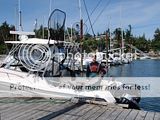quote:
Originally posted by ratherbefishing
Thank again guys. Any real world experience with Class D vs regular DSC?
A request tho please Charlie, I know you quote a lot of articles in your responses and I think we all appreciate your efforts but when doing so could you please reference the article? For example, the info you provided to my info request was almost verbatim from
http://www.yachtingmagazine.com/article.jsp?ID=21014386 (which I had already reviewed). There is lots of good stuff other than that which you copied and I think the authors deserve credit.
Cheers
rbf... I quote a "lot" from different articles and try “very hard” to give credit where credit is due and provide the references, especially on copyright material! That is why you will see all those “links” in my posts! Just for that reason! For reasons you do not know I am actually sensitive to that issue! I agree, one should get credit for their work! Some are just the proper thing to do - and depending on the circumstances, some are legally required!

The reference to the article you gave was actually a re-write and has been done so, many times. I am not sure “who” is/was the “original” author of that article, but I don’t believe it was they that you referred to? That particular article is a re-write from their own 2005 article, which “that” article was sourced from different articles. Much of it could have even come from Westmarine "West Advisors", which also has no author given. They all have and use the same terminology and wording! Also note there is "no" copyright on any – there is a reason for that! Since you mentioned it, as far as I can tell the original article was published in Boat/US magazine, September 2000 and Copyright 2000 Boat Owners Association & Gale Group. It appears all the rest are just rewrites and updates from there? So I believe, if any - that would be your correct credit?
http://findarticles.com/p/articles/mi_m0BQK/is_5_5/ai_65513074/
http://www.westmarine.com/webapp/wc...sor/10001/-1/10001/VHF-Fixed-Mount-Radios.htm
I will give "Chuck Husick" credit for being (and writing) a lot of things - he seems to have gotten around quite a bit? There are many articles published with his name; however, if he is/was the “original” author of any and Boat/US or BOA does not have a copyright, I would be surprised! Personally, I quit digging that deep. I know if it is commercially published and “not” copyrighted, the information has been taken from “public domain” or compiled from other sources. Just check the newspapers and see how many articles have a copyright?
Now with all that said… again, I am sensitive to work done by others and I actually do have copyrights. I agree whole-heartedly in giving credit where credit is due… Hope all this makes sense?

Now with that out of the way... "real world experience"?? Is that referring to me?? If so, I believe owning and operating VHF radios since 1977, might give me a little "real world experience"? Since in the past have owned DSC with Class "D" and currently own an ICOM-602 Class "D" I guess that would qualify me on both counts??


And may I say again... "you need to read the specifications"? If you think ITU isn't on VI and in Canada, you might want to check a little closer? And, unless something has changed I don't believe ITU is TC authorized on any "commerical" craft - but?? Here is a good example... how many ICOM-602 are in Canada? My ICOM-602 Class "D" clearly states, "Built-in DSC meets ITU Class D requirement"! Notice it does "NOT" say anything about "IEC"? Now if you really want, pull up the following owners manual, go to specifications, under receiver... it states "•Receive system : Double conversion superheterodyne". Look through the whole owners manual for anything referring to IEC... it isn't there! It does not list any dual receiver, nor say anything about dedicated to channel 70 in the specs. But if you go to page 34 you will see how it works!

As stated not all VHF DSC Class "D"... are created equal! I guess this could count for first hand "real world experience" with DSC and Class D, ITU, and IEC? Once more, know what you are buying! [:0][:0]
I will let you research what the "Double conversion superhetrodyne" is, that took me awhile!

 http://www.icomamerica.com/en/downloads/DownloadDetails.aspx?Document=96
http://www.icomamerica.com/en/downloads/DownloadDetails.aspx?Document=96
Oh... forgot! I wrote this, so no other credits required!


Cheers!


